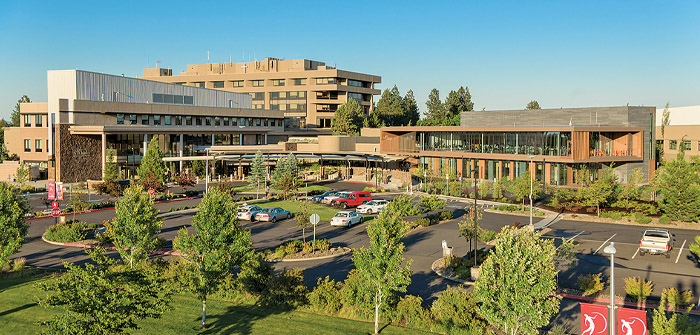(Photo | Courtesy of St. Charles Health Systems)
The healthcare industry in Oregon often reflects many of the challenges and trends seen in the industry across the nation, and this last year was no different. The industry is still recovering from the COVID-19 pandemic, in terms of both financial instability and staffing issues. The pandemic exacerbated issues that had been growing for years, resulting in our current situation: many rural communities lacking sufficient, or in some cases, any, health services.
In addition, healthcare in Oregon has been a hot topic in Salem. Governor Tina Kotek and Oregon legislators signed House Bill 2002 and House Bill 2697 during this 2023 legislative session; the first bill aims to protect access to reproductive healthcare across the state, while the latter aims to alleviate staffing issues and healthcare worker burnout while also increasing the standard of care for patients, despite facing some initial backlash from some voices in the healthcare industry who saw the regulations as unrealistic and dangerous.
Now, the Oregon Legislature is reexamining the eligibility for every person on the Oregon Health Plan, the state’s version of Medicaid. According to a report by the Oregon Capital Chronicle, coverage will continue only for people whose income level is at most 138 percent of the federal poverty line: $20,120 a year for a single person or $41,400 a year for a family of four. A temporary waiver was approved to maintain coverage of people and families who make 138 percent to 200 percent of the federal poverty line, but the long term coverage of this group is still up in the air.
Needless to say, Oregon’s healthcare industry has been tumultuous. In the words of Mark Hallett, MD, senior vice president and chief clinical officer for St. Charles Health Systems, “Healthcare is in a dynamic time.”
Hallett continued, stating that “Many health systems are struggling post-pandemic. However, some have been able to come out stronger. We’ve taken action to reduce cost and adjust contracts to increase revenue.”
Hallett said that these tactics have helped St. Charles in this post-pandemic era, putting the health system’s finances “in the black.” However, while Hallett is grateful for the recent financial success, he recognizes that many other health systems across the state and country are not as fortunate.
“In other parts of Oregon and the US, rural health and critical access hospitals are financially struggling and risking closure,” Hallett said.
Continuing, Hallett pointed out that many areas struggling to maintain access to healthcare are areas that have already struggled in this arena; areas that used to just have limited access are now at a high risk of losing all access.
This issue of losing access to healthcare is made worse by staffing and financial issues. According to Hallett, these two issues are the biggest that the healthcare industry is facing.
“The biggest two challenges are staffing issues and the overall revenue model,” Hallett said. “Reimbursement is not meeting rising inflation and the cost of living. In Oregon, there’s been an effort to limit increased cost on the populace while simultaneously addressing rising costs.”
The rising cost of operating a health system like St. Charles, which has 4,436 employees and operates in a 32,000-square-mile region in Central and Eastern Oregon, comes at a rough time. Hallett said that this year has been a particularly busy one, with demand “at its highest ever.”
Aside from staffing and financial issues, this increased demand is a result of an aging population. Bend has been a popular spot for retirees for decades now, and with a population growing as quickly as ours, it makes sense that our community has many senior citizens who need care from the St. Charles.
To address this increased demand, St. Charles has recently come up with some programs aimed at increasing the number of CNAs, or Certified Nursing Assistants, in the region. According to St. Charles, the health system was experiencing a massive shortage of this specific position back in 2020 when only 30-40 percent of these positions were regularly filled.
A partnership established between St. Charles and Central Oregon Community College aims to fix this. Since 2020, this partnership and the resulting CNA training has trained 165 CNAs who were able to get hands-on experience at St. Charles while completing the program.
Julie Downing, instructional dean overseeing Allied Health programs at COCC, stated, “With our nationally certified curriculums, established clinical partnerships, and experienced local faculty, COCC was able to quickly deploy an accelerated, on-site cohort model specifically for St. Charles,”
Because of the success of this partnership, St. Charles started a similar program for medical assistants in 2022, and is in the early stages of developing a similar program with COCC for pharmacy technicians. In addition, St. Charles is working on a residency program in Madras, partnering with other healthcare organizations to train family physicians for rural and underserved communities.
While COVID-19 made many existing issues in the industry worse, it also pointed out many advantages that the industry had, including some creative and innovative new solutions to access issues.
“COVID pushed the industry to evolve and utilize things like virtual visits, along with other ways of interacting and providing care digitally,” Hallett said. “Healthcare is still a service administered by humans and that’s not changing, but certain factors like COVID and staffing shortages have pushed the industry to seek creative solutions.”
Continuing, he said, “COVID proved that virtual care can be successful in many ways. We utilized digital care in our hospitals and it drove the innovation that led to virtual visits. Like many other big challenges, it showed the teamwork and resiliency of a wide variety of community resources. Things like mass vaccine clinics and drive through testing showed us that the ability to work with community partners can make a huge difference.”
Another factor affecting workforce burnout and staffing shortages is the issue of public trust in the healthcare system. Hallett spoke about the tough transition, from having healthcare workers praised as heroes and essential workers, to seeing a sharp increase in combative behavior, distrust in mainstream treatments and overall mistrust in healthcare workers. Hallett said that this issue of trust has definitely exacerbated existing staffing issues and burnout.
There’s another issue on the minds of Central Oregonians; the potential decision for some healthcare providers, including St. Charles, to cease their participation with Medicare Advantage plans, including those from Humana, PacificSource, HealthNet and WellCare.
St. Charles stated in a press release that the decision to evaluate the health system’s participation in Medicare Advantage plans comes after “years of concerns piled up not just at St. Charles, but at health systems throughout the country,” citing concerns related to patient care, access and affordability.
The press release continued, stating, “Should St. Charles no longer be considered ‘in-network’ with these Medicare Advantage plans, patients who are currently on these plans may need to choose another insurance plan to avoid changes in insurance coverage or payment responsibilities.”
Hallet was quoted in the press release, stating, “We strongly encourage anyone currently on a Medicare Advantage plan living in Central Oregon to review their health insurance coverage during open enrollment this fall and consider making a change to traditional Medicare.”
Despite a rough few years for the Central Oregon healthcare industry, Hallett is optimistic about the future, and sees the last year as a turning point for St. Charles.
“We’re moving forward in a spirit of supporting our people and delivering results,” he said. “It’s a huge positive that we’re now financially stable because now we can reinvest in our people. We recognize the responsibility of being the only referral center east of the Cascades, and we’re ready to take on that responsibility for our community and our region.”
Hallet closed out the interview by stating how proud he is of the St. Charles workforce, and the care that they have provided the community; stating that he and the entire workforce follow the “care for all” motto carried by St. Charles.





